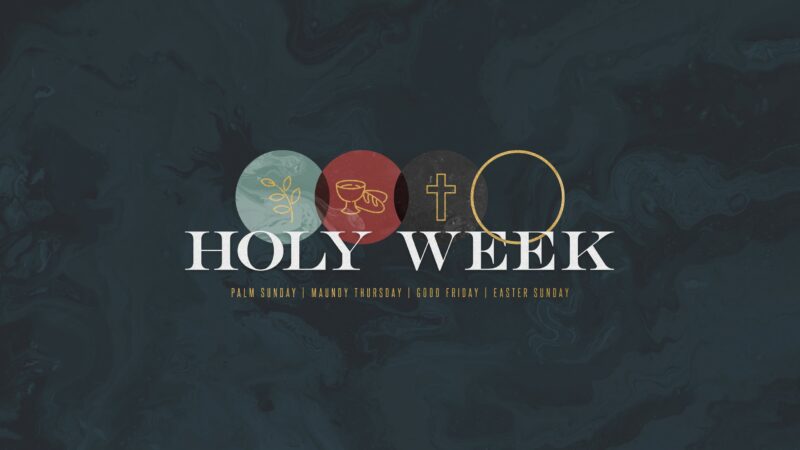Palm Sunday Texts: (Matt 21:1-11, Mk 11:1-11, Luke 19:28-44, Jn 12:9-19)
What does Palm Sunday mean to you? At first glance, this holiday seems kind of irrelevant. Palm branches? Festivals? A man riding a donkey and a Jewish crowd shouting “Hosanna!”? What does this story have to do with my life today?
Today Christians around the world begin the celebration of “Holy Week”: the last week of Jesus’ life. This is the week between Palm Sunday and Easter Sunday. This action-packed period of just seven days was the focus and culmination of Jesus’ entire ministry career. This is why a disproportionate amount of space is given to this final week in the gospel narratives. It was Martin Kähler who famously described Mark’s Gospel as a “passion narrative with an extended introduction.” [1] Indeed, the Son of Man came to give His life as a ransom for many (Mk 10:45). It is our hope that these daily devotionals will guide you through the Scriptures on this sacred week and strengthen your walk with God.
As you consider day one, ask yourself this question: Exactly what kind of saving did Jesus come to bring you? Did he bring us saving from all our political problems? All our health problems? Our economic problems? Our family problems? What kind of saving did Jesus come to bring you? This is a question about expectations. This is important, as Jesus may not be offering what you expected. It certainly isn’t what they expected back in the first century. Let’s read Mark 11:1-10:
As they approached Jerusalem and came to Bethphage and Bethany at the Mount of Olives, Jesus sent two of his disciples, saying to them, “Go to the village ahead of you, and just as you enter it, you will find a colt tied there, which no one has ever ridden. Untie it and bring it here. If anyone asks you, ‘Why are you doing this?’ say, ‘The Lord needs it and will send it back here shortly.’ ” They went and found a colt outside in the street, tied at a doorway. As they untied it, some people standing there asked, “What are you doing, untying that colt?” They answered as Jesus had told them to, and the people let them go. When they brought the colt to Jesus and threw their cloaks over it, he sat on it. Many people spread their cloaks on the road, while others spread branches they had cut in the fields. Those who went ahead and those who followed shouted, “Hosanna! ” “Blessed is he who comes in the name of the Lord!” “Blessed is the coming kingdom of our father David!” “Hosanna in the highest heaven!”” (Mk 11:1-10, NIV)
When Jesus rode into Jerusalem on a donkey, this triumphal entry was a glorious fulfillment of prophecy (Zech 9:9). This fits the description of the king that would come from Judah’s line (Gen 49:8-12). The reader familiar with the Old Testament will remember a similar ride made by David’s son Solomon (1 Kgs 1:38). In this culminating event, Jesus was presenting Himself to the nation of Israel formally as their king.
HISTORICAL BACKGROUND:
Palm branches were used in a similar fashion in the 2nd century B.C. to welcome another great hero in Israel, Judas Maccabeus. Before Rome rose to power, Israel was conquered by the empire of Greece under the rule of Alexander the great. For the most part, this was a peaceful time. However, a vicious tyrant came to power in Greece named Antiochus Epiphenes around 165 B.C. This man was determined to wipe out Judaism altogether and put into place the Greek religion. It was a time of severe persecution. This is when we meet the very famous historical character named Judas Maccabeus. He led a revolt and fought back against Greece … and won! It was awesome! After he won the war, he and all of his warriors headed back to Jerusalem for their victory march and look how they greeted him: “With praise and palm branches…because a great enemy had been…removed from Israel.”[2]
Interesting right? I give you this background because I want you to understand the kind of expectations the crowds had for Jesus on Palm Sunday. The people of the first century had hoped Jesus would give them freedom from the oppression of Rome. They expected and wanted a Messiah who would rescue them from all their political troubles. They wanted someone who would save them from what they thought was their greatest problem – the Romans! That’s why they shouted “HOSANNA!” which means “Save us!” “Save us … from Rome!”
A DEEPER KIND OF SAVING
That background is helpful for our understanding, but what they didn’t realize is that they needed a much deeper kind of salvation. There was a problem worse than Rome, it was the problem of sin. Do you know that Easter occurred during the Passover feast? Do you know what day Palm Sunday fell on in the Jewish Calendar that year? It was on the 10th of Nisan. Do you know why that’s significant? That is the exact day they would select the lamb for each household to be slaughtered during the Passover feast. You may remember it had to be a young male lamb, without spot or blemish (Ex 12:3).
Therefore, do you see what’s happening on Palm Sunday? Jesus is the Lamb of God. The prophet Isaiah said “He was led like a lamb to the slaughter” (Isa 53:7). God the father had chosen the perfect sacrifice. Jesus truly is “The Lamb of God, who takes away the sin of the whole world.” (Jn 1:29) This may not be what they expected, and this may not be the kind of saving we wanted, but this is the kind of saving we needed. Palm Sunday is about a man who is volunteering to die. He is volunteering to die … for you.
Prayer: Thank you Jesus for coming in meekness and humility. Thank you for coming to save us. Thank you for taking my place. Thank you that through your shed blood my sins can be lifted up and carried away.
Tomorrow we will consider the events of Day 2.
Holy Week Devotionals:
- Day 1 – Palm Sunday
- Day 2 – Monday
- Day 3 – Tuesday
- Day 4 – Wednesday
- Day 5 – Maundy Thursday
- Day 6 – Good Friday
- Day 7 – Holy Saturday
- Day 8 – Resurrection Sunday
[1] The So-called Historical Jesus and the Historic, Biblical Christ, 80 n. 11.
[2] 1 Maccabees 13:51




